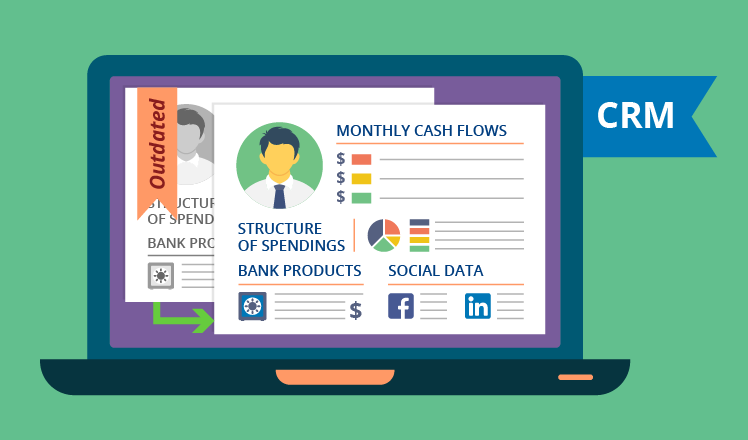Why updates of customer profiles in banking CRM matter
Customer data management often turns out to be a low priority for banks when they only want to focus on more topical issues, such as cutting costs or enhancing daily banking activities. However, buying a bank CRM and then leaving the whole database without any further updates is a waste of money. Banking executives should remember that relying on poor-quality data can disrupt building long-term relationships with customers. Let’s see why and how to timely update banking CRM to create more effective marketing campaigns.

Why update customer profiles
Changes in the banking industry are not only inevitable, but happen more frequently than even 20 years ago due to increased pace of financial operations. Whether people change jobs, relocate to a new place, change the marital status or retire, a banking CRM system should reflect all these changes since they influence promotion activities and risk assessment. For example, if a customer gets dismissed from their job, a bank should timely update their banking CRM and, if necessary, reconsider the current interest rate and available credit limit.
CRM data should be updated since it affects the quality and duration of relationships. Otherwise, it simply makes customer communications irrelevant. In fact, according to the Experian research, 97% of the U.S. companies suffer from common errors associated with contact data. One of the most common data errors is outdated information mentioned by 48% of respondents, and it’s at least 10-20% of data becoming inaccurate or outdated each year. Experian states that over the 7 years of survey on data quality, the amount of companies reporting outdated and inaccurate data has increased. That’s why the longer a bank waits to update their CRM data, the more irrelevant details sales consultants will find in customer profiles.
N.B.: For a complete list of data that should be tracked in a CRM customer profile, have a look at this demo.
Identifying outdated profiles
ScienceSoft’s CRM consulting specialists identified the tools and channels for a timely update of customer profiles. For example, a bank can keep track of whether a customer has changed location by monitoring where he/she recently visited the bank’s branches, or checking location data in a mobile banking app. To track changes in a customer’s income level, bank representatives may require technology that allows analyzing monthly cash flows and then suggesting an update. The structure of expenditures (in case a customer pays with a card) can tell about changes in buying behavior while loan applications or purchased bonds can alert to customers’ personal financial goals. A retail bank can also benefit from monitoring social networks to identify customer life changes, such as a change of the marital status or a new occupation. In fact, Facebook is the best source on customers’ everyday lives whereas LinkedIn helps to track major updates in customers’ careers.
A side note. Create the “last review date” field in customer profile
Adding this field in your banking CRM can help sales representatives or other employees to sort out those profiles that may need updating. Also, banking executives can estimate the general state of their CRM, that is, how often it’s reviewed and updated.
Keeping up with customers’ lives
As long as the profile stays outdated, marketing specialists and sales representatives should either postpone further profile-based activities, such as sending promotions, making targeted offers, etc., or carry them out as it goes without personalization. Otherwise, bank specialists risk making irrelevant offers or, what is worse, sending data to the wrong recipients. The following tips will help banks to maintain data hygiene timely:
1. Define frequently used fields. Default customer profiles usually include a number of fields that employees may never use. Instead of trying to fill in all the fields, it’s better to focus on the most valuable customer data and try to keep it up to date. CRM consulting specialists can help banks define those customer parameters of the biggest importance.
2. Perform constant checks of customer data. Every time a bank gets a new letter, e-mail or any other form of incoming data from customers, bank consultants should take the opportunity to compare information in customer e-mail signatures or addresses with the data in CRM. Even if there are no changes, employees should update the last review date.
3. Educate sales force to update CRM. Apart from optimizing operational processes, an up-to-date CRM system can facilitate sales process and thus increase commissions of a bank’s sales representatives. Therefore, banking executives should clearly communicate their sales team the necessity of keeping CRM data squeaky clean.
Update is a necessary hassle
Accurate and up-to-date customer profiles are the cornerstone for any retail bank that wants to have successful and long-term customer relationships. The quality of data stored in a banking CRM system directly affects sales and marketing success: the cleaner the data, the higher results these teams can show in terms of closed deals or achieving cross-selling results. The quality of data can also affect a bank’s budget and image in case it sends e-mails or letters to the wrong recipients or falls short of keeping up with customers’ lives.
If a retail bank does not succeed in achieving and maintaining a high quality of customer data, the potential of CRM cannot be fully realized. Updating customer profiles in CRM is a challenging task, but otherwise it all just leaves long-term customer relationships and increased efficiency purely theoretical.

